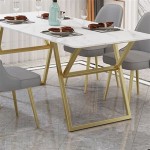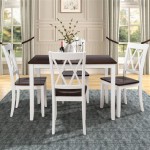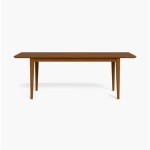The Enduring Appeal of Round Dining Tables in Light Wood
Round dining tables have remained a popular choice for homes of various styles for decades. Their inherent design fosters conversation, promotes inclusivity, and often optimizes space. When crafted from light wood, these tables gain an added dimension of visual appeal, contributing to a bright and airy atmosphere. This article will explore the enduring appeal of round dining tables in light wood, examining their aesthetic versatility, spatial advantages, and the diverse styles they can complement.
The selection of a dining table is a significant decision in interior design. It serves as a focal point in the dining area, influencing the flow of the room and setting the tone for meals and gatherings. Round tables, in particular, encourage a more intimate and egalitarian dining experience. The absence of a defined head or foot of the table allows for easier interaction and promotes a sense of community among diners. Furthermore, the use of light wood enhances these advantages, contributing to a welcoming and comfortable environment.
Aesthetic Versatility: Light Wood's Adaptability
Light wood, in its various forms, possesses an inherent versatility that makes it suitable for a wide range of interior design styles. From the clean lines of Scandinavian minimalism to the rustic charm of farmhouse chic, light wood can seamlessly integrate into diverse aesthetic schemes. The pale hues of woods like birch, maple, ash, and pine provide a neutral backdrop that allows other elements in the room to stand out. This adaptability is a key factor in the enduring popularity of light wood round dining tables.
In a Scandinavian-inspired setting, a round dining table crafted from light birch or ash would perfectly complement the minimalist aesthetic. The clean lines and natural warmth of the wood would create a serene and inviting space. Paired with light-colored chairs and natural textiles, the table would contribute to the overall sense of calm and simplicity. In contrast, a light wood round dining table with a more rustic finish could anchor a farmhouse-style dining room. The addition of distressed elements or visible wood grain would enhance the table's character and create a warm, inviting atmosphere.
Furthermore, light wood offers a versatile canvas for incorporating different design details. A round dining table with a simple, unadorned design can be easily dressed up or down depending on the occasion. A patterned tablecloth, colorful placemats, and decorative centerpieces can transform the table's appearance to suit different events and preferences. Conversely, the table can be left bare to showcase the natural beauty of the wood itself, emphasizing its clean lines and minimalist appeal. The adaptability of light wood to various decorative styles is a significant advantage for homeowners who enjoy changing their interior design periodically.
Beyond specific styles, the choice of light wood can also influence the overall mood of the dining area. Lighter shades of wood tend to create a brighter and more spacious feel, while slightly darker tones can add warmth and depth. The selection of a wood finish, such as a natural oil or a matte lacquer, can further enhance the wood's character and protect it from everyday wear and tear. The aesthetic versatility of light wood, coupled with the inherent advantages of a round dining table, makes it a compelling choice for homeowners seeking a stylish and functional dining solution.
Spatial Advantages: Optimizing Room Layout
Round dining tables inherently offer spatial advantages, particularly in smaller dining areas or rooms with unconventional layouts. Their circular shape allows for a more efficient use of space compared to traditional rectangular tables. The absence of sharp corners makes it easier to navigate around the table, creating a smoother flow of traffic. This is particularly beneficial in smaller apartments or homes where space is at a premium. Furthermore, the symmetrical shape of a round table allows for equal spacing between diners, promoting a sense of balance and harmony in the room.
In square or irregularly shaped rooms, a round dining table can be particularly effective. Its circular form helps to soften the angles of the room and create a more balanced and inviting space. The table can be strategically placed to fill awkward corners or to create a focal point in the center of the room. The use of light wood further enhances these spatial advantages by visually expanding the space. The pale hues of the wood reflect light, making the room feel brighter and more open. This is especially important in smaller dining areas where natural light may be limited.
Moreover, round dining tables are often available in a variety of sizes, allowing homeowners to choose a table that is perfectly suited to their needs and the dimensions of their dining area. Smaller round tables are ideal for intimate gatherings or for couples living in apartments. Larger round tables can accommodate larger families or groups of friends, providing ample space for dining and socializing. The flexibility in size, combined with the spatial advantages of the circular shape, makes round dining tables a practical and stylish choice for a wide range of homes.
The ease of movement around a round dining table also contributes to its spatial advantages. Unlike rectangular tables, which can create bottlenecks and impede traffic flow, round tables allow for a more seamless transition between different areas of the room. This is particularly beneficial in open-plan living spaces where the dining area is integrated with the living room or kitchen. The smooth, circular shape of the table encourages a more natural and intuitive flow of traffic, minimizing clutter and maximizing the use of space. The combination of spatial advantages and aesthetic appeal makes round dining tables in light wood a popular choice for homeowners seeking to optimize their living space.
Complementing Diverse Styles: From Modern to Traditional
The versatility of light wood round dining tables extends beyond specific design styles; they can effectively complement a wide spectrum of interior aesthetics, from modern and contemporary to traditional and rustic. The key is to consider the details of the table's design, the specific type of wood used, and the surrounding decor to create a cohesive and harmonious look. Light wood serves as a neutral foundation that allows other elements in the room to shine, while also adding its own unique character and warmth.
In a modern or contemporary setting, a light wood round dining table with clean lines and a minimalist design would be an ideal choice. The table could be paired with sleek, modern chairs in neutral colors or bold accents to create a visually striking contrast. The use of geometric patterns, metallic accents, and abstract artwork would further enhance the contemporary aesthetic. The light wood would provide a sense of warmth and naturalness, balancing the cool tones and sharp angles often found in modern interiors.
For a more traditional dining room, a light wood round dining table with ornate details or a pedestal base would be a fitting choice. The table could be paired with upholstered chairs in classic fabrics like linen or velvet, and the room could be decorated with antique furniture, traditional artwork, and elegant lighting. The light wood would complement the traditional aesthetic while also adding a touch of freshness and modernity. The use of floral patterns, warm colors, and rich textures would create a cozy and inviting atmosphere.
Even in more eclectic or bohemian-inspired settings, a light wood round dining table can find its place. The table can be paired with mismatched chairs, colorful textiles, and unique decorative objects to create a personalized and expressive dining area. The light wood would serve as a unifying element, tying together the diverse elements of the room. The use of natural materials, such as rattan and bamboo, would further enhance the bohemian aesthetic, creating a relaxed and inviting space.
The ability of light wood round dining tables to complement diverse styles is a testament to their enduring appeal. They are not limited to a specific design trend or aesthetic; instead, they offer a versatile and adaptable foundation for creating a dining area that reflects the homeowner's personal style and preferences. The choice of wood, finish, and accompanying decor can transform the table's appearance, allowing it to seamlessly integrate into a wide range of interior design schemes. Whether the goal is to create a modern and minimalist space, a traditional and elegant dining room, or an eclectic and bohemian-inspired setting, a light wood round dining table can serve as a stylish and functional centerpiece.

Sol Round Wood Dining Table In Black By World Market

Round Dining Table Solid Wood Circular Kitchen Tapered Wooden Legs Large 119cm Natural Light Handmade Inside Etsy

Home Decorators Collection Cranford 48 In Modern Round Solid Light Natural Wood Dining Table With Fluted Pedestal Base Seats 4 Bki 83323 The

Anton Round Pedestal Dining Table 48 60 72

Ellington Round Dining Table 48

Blanca Round Whitewash Wood Dining Table World Market

Solid Wood Round Small Space Kitchen And Dining Table Light Oak Finish Tan The Vermont Country

46 Inch Modern Wood Round Dining Table Tabacco Oak Room Kitchen Color

Worlds Away Hamilton Tapered Base Round Dining Table Cerused Oak

Stylewell Round Pedestal Unfinished Natural Pine Wood Table For 4 42 In L X 29 75 H T 01 The Home








